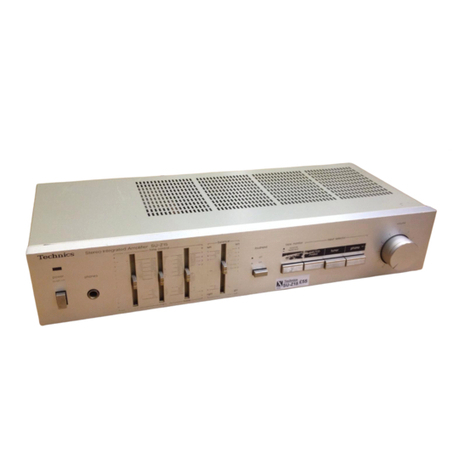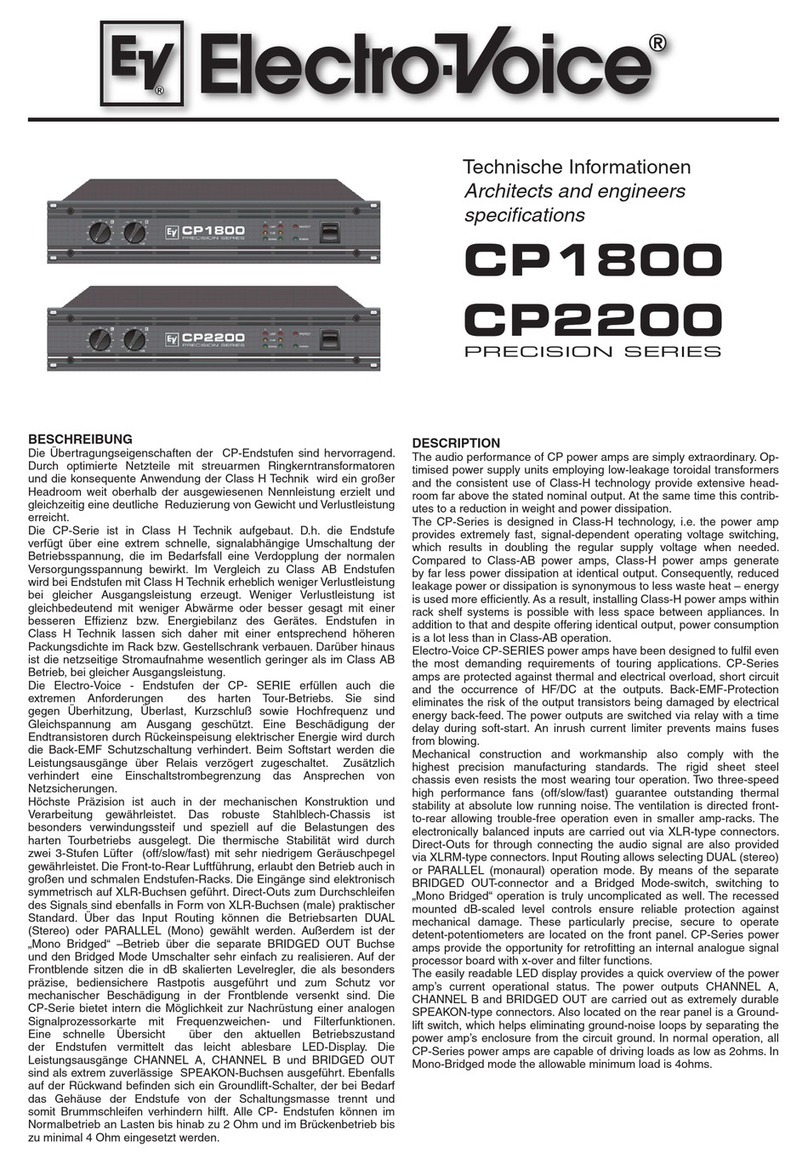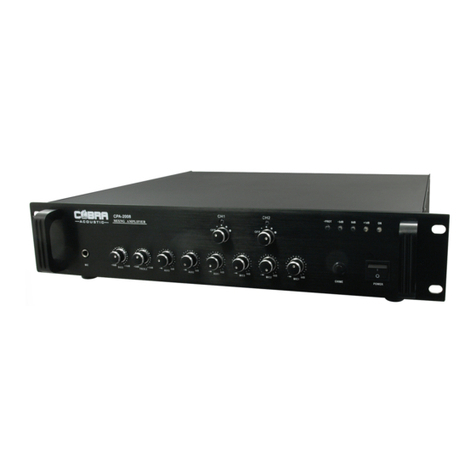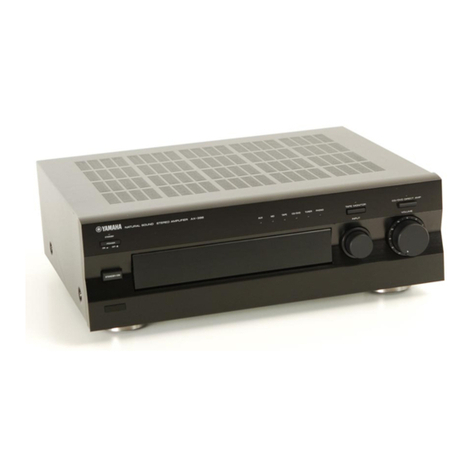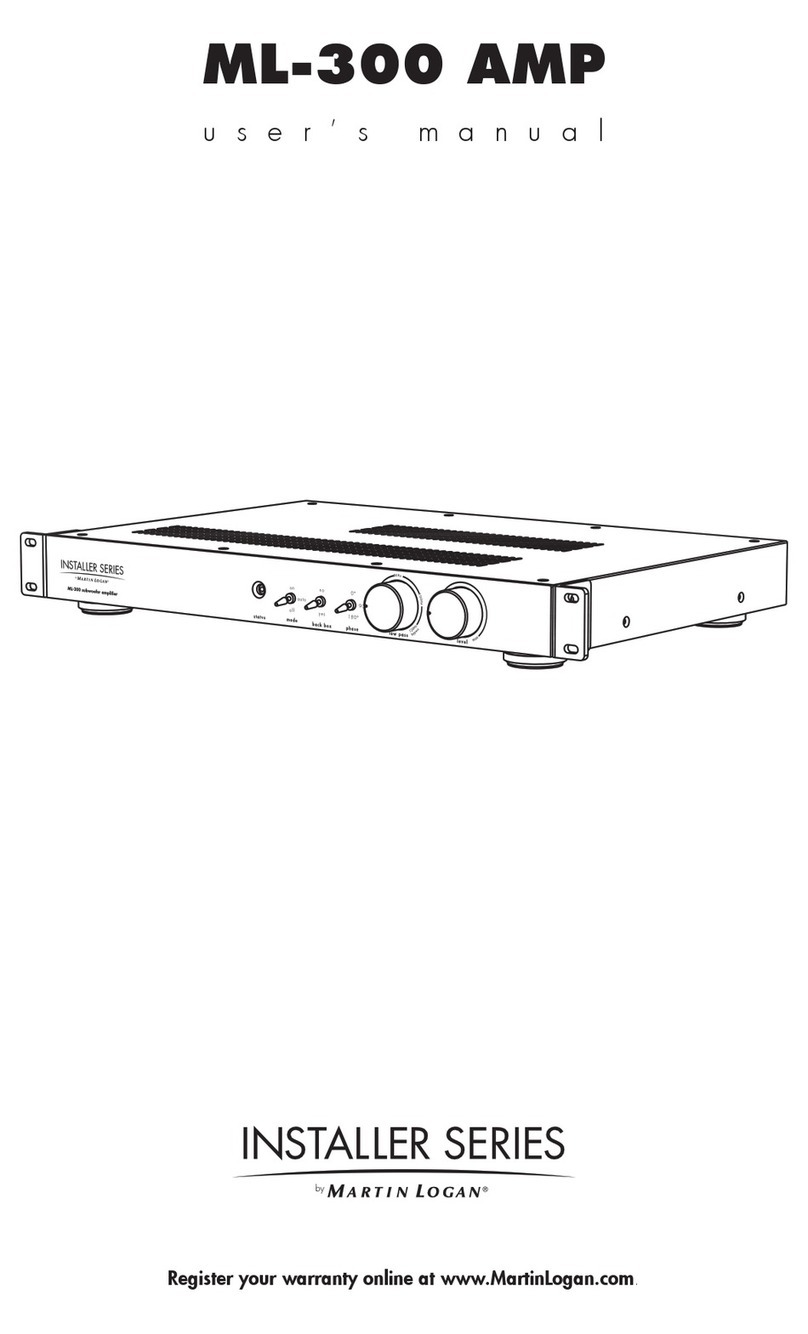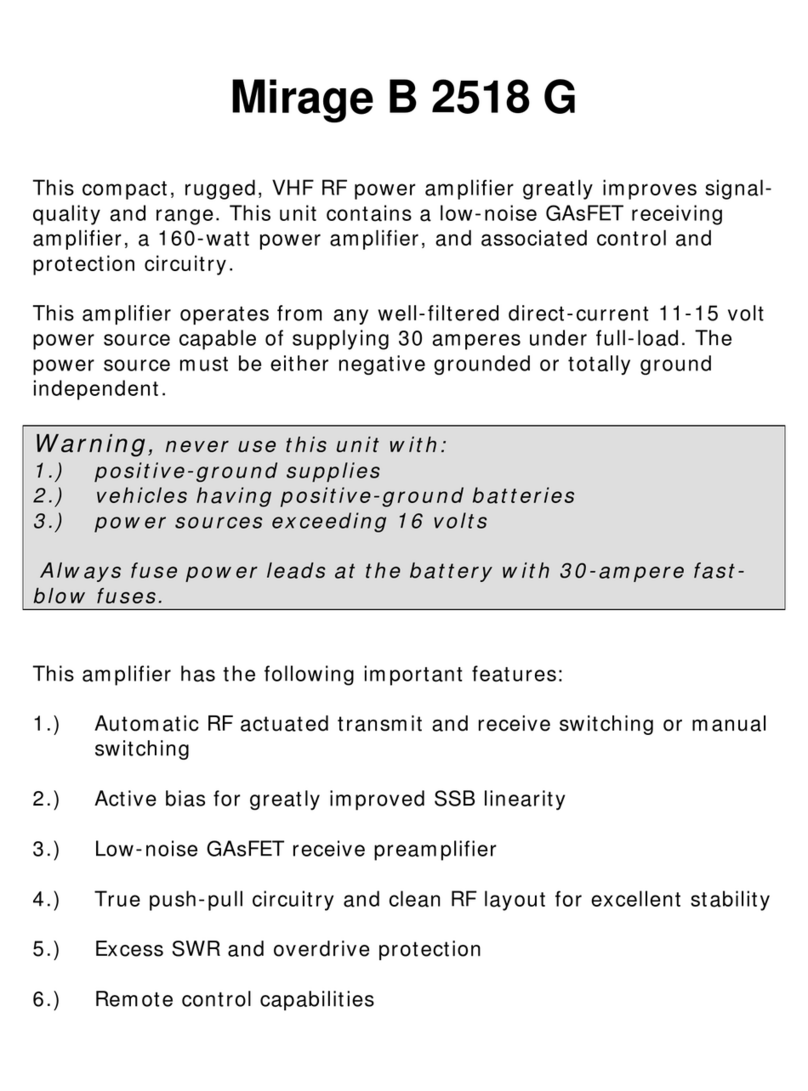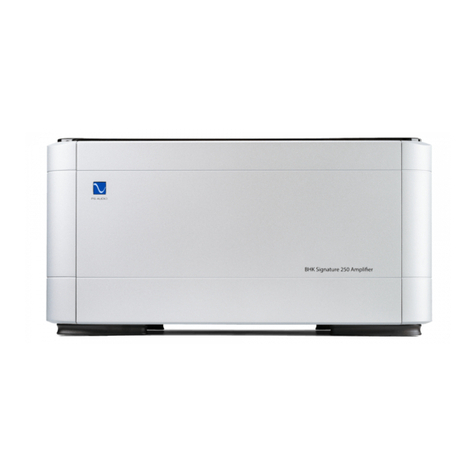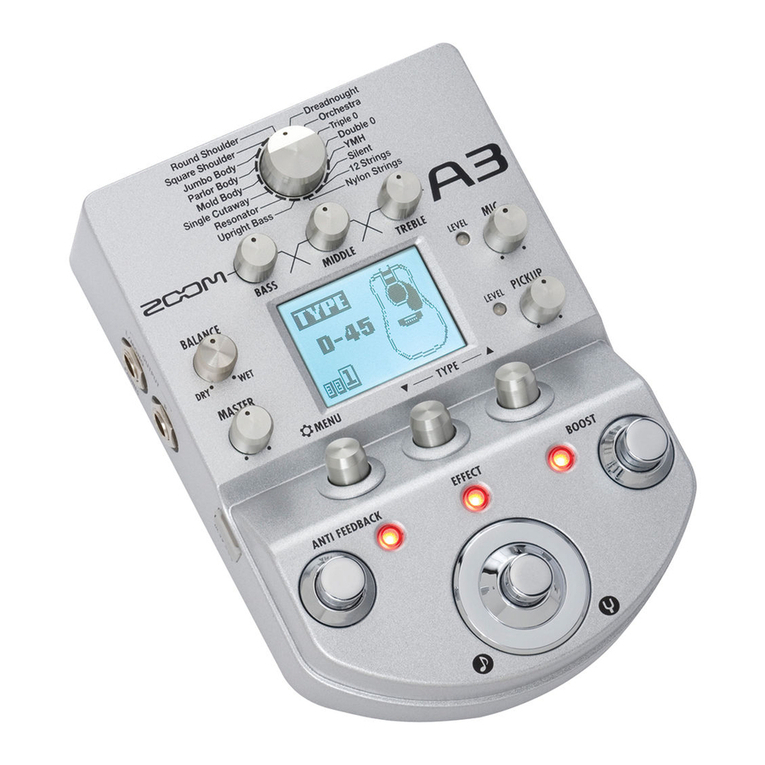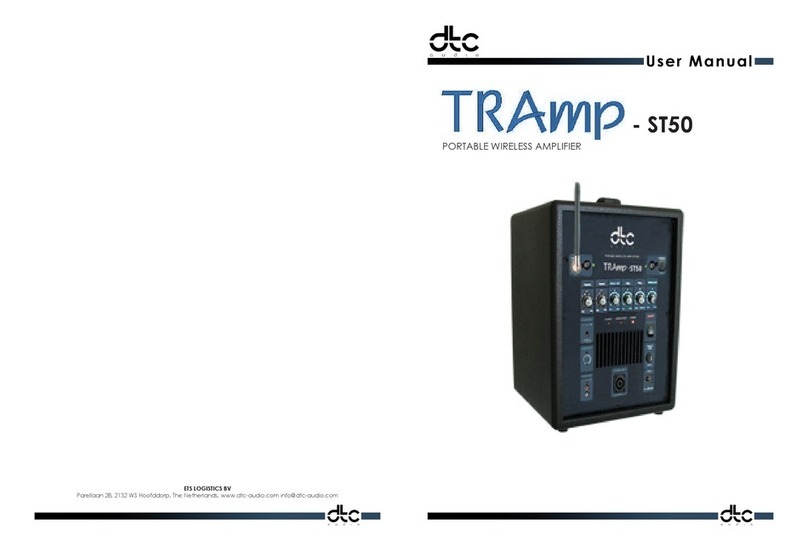Birdland Audio Odeon-m1 User manual

1
The way music should sound Odéon-m1
Odéon-m1
Owner’s Manual
24 bit Digital to Analog Converter
Passive Preamplifier
Birdland Audio
P.O. Box 51863
Pacific Grove, CA 93950
http://www.birdland.com

The way music should sound
2
Odéon-m1
Dear Audiophile,
On behalf of Birdland Audio, I would like to thank and congratulate you on your acquisition of our
24 bits Digital-to-Analog Converter (DAC) and preamplifier, the Odéon-m1. As digital techniques
have greatly been improved over the past 10 years and with the recent availability of 24bits / 96kHz
masters on DVD, we wanted you to be ready to jump to the next level of digital experience by
providing you with this technologically advanced DAC.
The Odéon-m1 not only converts any digital format from 8 to 24 bits at sampling rates of 32kHz,
44.1kHz, 48k, 88.2k and 96kHz but it is also a passive preamplifier which allows you to connect
yourlegacycomponentssuchasatape-deck,tunerorreceivertoitsanalogbypassinputs.Ofcourse,
the Odéon-m1 takes advantage of our 14 years of experience and knowledge in the audio domain to
provide you with the most natural sounding DAC available today at any cost.
Our only trade secret is elegance of the whole design and quality of every component. You will be
pleased to find only the highest quality components in our products and the finest audiophile parts.
I am sure you will appreciate the Odéon-m1 as much as I do and I wish you many hours of true
revelation as you listen to music the way it should sound.
Sincerely,
Gilles Gameiro
President / Design Engineer

3
The way music should sound Odéon-m1
Table of Contents
1 - Safety instructions and important notes...............................................4
2 - How to properly care for your DAC.....................................................5
3 - Identification of controls......................................................................6
5 - Connecting the Odéon-m1 ..................................................................9
5.1 -The Digital Inputs ..........................................................................9
5.2 - The Analog Inputs ........................................................................10
5.3 -The Outputs.................................................................................11
5.3 - The Monitor Feature ....................................................................12
6 - Technical Specifications .....................................................................14

The way music should sound
4
Odéon-m1
1 - Safety instructions and important notes
Pleasereadandobservethewarningsandinstructionsinthisowner'smanualtoinsureyourpersonal
safety and proper care of your unit.
The Odéon-m1 digital-to-analog converter has been designed with safety in mind.
Improper use may however result in electric shock or fire hazard. Please read the following safety
instructions carefully.
1 Do not remove the unit’s cover as you will be exposed to dangerous voltages which may result in
electric shock. Refer servicing to qualified technicians only.
2 When connecting components to your Odéon DAC, it is a good idea to turn it off or to make
sure that it is not connected to the main electrical outlet.
3 To reduce the risk of fire or electric shock, do not expose the Odéon DAC to rain or heavy
moisture. Wait at least one-half hour before plugging the amplifier in after transferring it from a
cold place to a warmer room allowing for internal condensation of water to dissipate.
4 The Odéon DAC has openings provided for ventilation. Proper operation may only occur if
theseopeningsarenot obstructedorcovered. Donotcovertheunit.Itshouldnotbe usedinabuilt-
in installation such as a bookshelf or rack unless proper vertical ventilation is provided.
5 Itstronglyrecommendedtolowerthevolumeknobto theminimumbeforeturningyourOdéon
DAC on if the attenuated output is being used. Failing to do so could send high audio levels to your
amplifier and could overload and damage your amplifier or speakers.

5
The way music should sound Odéon-m1
2 - How to properly care for your DAC
Heat
Keep the Odéon DAC away from heat sources such as radiators, space heaters, stoves or other
sources.
Water and moisture
Do not use the Odéon DAC near water sources such as bath tubs, sinks, wash bowls, swimming
pool or other sources that may lead you to get water in the unit. Do not spill liquid of any kind on
the unit.
Objects entry
Do not insert objects of any kind through the unit's opening vents as they may touch electric parts
with dangerous voltages or may short-out parts inside and damage your DAC.
Stack and height
DonotstacktoomanycomponentsorheavyobjectsontopoftheOdéon. Doingthiscouldprevent
heat from dissipating properly out of the top vents and could cause damage or deformation to the
unit's case.
Cleaning
Use a simple damp soft cloth to clean. Do not use liquid or abrasive cleaners.
Make sure your Odéon is not connected to the electrical outlet before cleaning it.
Protection
For added protection, you may choose to disconnect your Odéon from the wall outlet if you are
planning to leave it unattended for a long period of time or during storms. This may prevent
damage due to lightning.
Volume
Reduce the volume on your preamplifier or Odéon to the minimum level before you turn on the
unit. Doing so will prevent sudden loud volume sounds which could cause speaker, amplifier or
hearing damage.

The way music should sound
6
Odéon-m1
3 - Identification of controls
1 Power On / Standby
2 Digital input 1 select
3 Digital input 2 select
4 Digital input 3 select
5 Analog input 1 select
6 Analog input 2 select
7 Analog input 4 select
8 Monitor On/Off
9 Mute -20dB On/Off
10 Volume control
11 Power on indicator
12 Digital 1 select indicator
13 Digital 2 select indicator
14 Digital 3 select indicator
15 Analog 1 select indicator
16 Analog 2 select indicator
17 Analog 3 select indicator
18 Monitor on indicator
19 Mute -20dB on indicator
20 32kHz digital conversion
21 44.1kHz digital conversion
22 48kHz digital conversion
23 88.2kHz digital conversion
24 96kHz digital conversion
25 De-emphasis material conversion
IndicatorsControls

7
The way music should sound Odéon-m1
1 Left non-attenuated analog output
2 Right non-attenuated analog output
3 Left attenuated analog output
4 Right attenuated analog output
5 Analog input 3 - left
6 Analog input 3 - right
7 Analog input 2 - left
8 Analog input 2 - right
9 Analog input 1 - left
10 Analog input 1 - right
11 Analog monitor input - left
12 Analog monitor input - right
13 Analog monitor output - left
14 Analog monitor output- right
15 Digital monitor input - fiber
16 Digital monitor input - coax
17 Digital monitor output - fiber
18 Digital monitor output - coax
19 Digital input 3 - fiber
20 Digital input 3 - coax
21 Digital input 2 - fiber
22 Digital input 2 - coax
23 Digital input 1 - fiber
24 Digital input 1 - coax
25 Power cord AC receptacle
26 Monitor mode select switch
Connections
Gilles Gameiro
Made in U.S.A.
French design by

The way music should sound
8
Odéon-m1
4 - Understanding the Odéon-m1
TheOdéon-m1ismainlya24bitDigital-to-AnalogConverter(DAC)andalsoacommoditypassive
preamplifier which allows you to not only connect digital but also analog sources.
A DAC is a unit that converts digital data from CDs or any other digital medias into analog music
that can be fed to a power amplifier for listening. Digital data is usually extracted from Compact
Disks(CD)usingatransport oraplayerandcanbe fedtotheOdéonthrougheither a digitalcoaxial
interconnect cable (commonly called S/PDIF) or a fiber optic. CDs store music using a digital
format of 16bits/44.1kHz but there are other formats which allow to increase the fidelity of digital
conversions such as the recent availability of 24bits/96kHz on audio DVDs (Digital Versatile Disk)
sometimesalsocalledDAD(DigitalAudioDisk).TheSuperAudioDiskformat-recentlyintroduced
by Sony/Philips - does not offer a way to carry digital data out of the box and are not compatible
with widely used S/PDIF or AES/EBU consumer and professional formats.
TheOdéon-m1willconvertanydigitaldatafrom12to24bitsatsamplingratesof32kHz,44.1kHz,
48kHz,88.2kHzand 96kHz. Youcanconnect3and up to 4differentdigitalsources to your Odéon
and use the buttons on the front panel to instruct it which source to convert.
TheOdéon-m1is also apassivepreamplifierthat allowsyou toconnect3andup to4existinglegacy
analog sources. Passive means that there are no active components in its analog section. You can
selectwhichanalogsourcetoroutetotheOdéonoutputandthesoundispassedonas-isunmodified
so you get out exactly what you feed in.
Your OdéonDACistheresultof the latest developments in both Digital and Analog domains along
with the highest quality components providing you with the most natural sounding conversion you
can get from your digital sources.
The DAC is a 24 bits delta-sigma converter which is composed of a 5th order digital interpolation
filter, a digital filter, a switched capacitor filter and a final 2nd order filter all developed together to
provide an overall constant group delay insuring no phase shift and a perfect stereo imaging. The
volume attenuator is a high-quality ALPS stereo potentiometer and the passive analog matrix is
made of the highest quality miniature air sealed relays with gold-plated over silver contacts.

9
The way music should sound Odéon-m1
There are three simple digital inputs on the back which can be used to connect digital sources
such as a CD, DVD player/transport or any other digital source. The Odéon DAC will receive
and decode digital audio data according to the AES/EBU IEC-958 also known as S/PDIF or
toslink as well as EIAJCP340/1201 professional(1) or consumer formats. The digital inputs are
activated using the front panels buttons In.1 through In.3 (see controls on page 6).
Whenconnectingthe AC3/PCM outputfromaDVDplayer to aOdéondigitalinput,make sureto
switch the DVD player format to PCM. RF outputs from laser disk players can not be connected
directly to the Odéon DAC without the use of a RF to S/PDIF converter.
Either optical OR the coaxial inputs can be used when connecting a source to the Odéon DAC for
each of the digital inputs. The Odéon will automatically select the format used but you should
NEVER connect both the coaxial and optical sources for any one input.
There was a time when optical receivers were not as performant as today. Recent technologies offer
excellent constant time delay optical transmitter/receivers. For this reason if the digital source offers
both optical and coaxial outputs, it is recommended to use the optical connection rather that the
coaxial as it ensures separation of the units grounds and offers signal immunity to EMI.
(1) Professional sources may require an impedance adapter from AES/EBU to 75 ohm S/PDIF. Such adapters
are commonly available from many sources.
Gilles Gameiro
Made in U.S.A.
French design by
5 - Connecting the Odéon-m1
5.1 - The Digital Inputs

The way music should sound
10
Odéon-m1
5.2 - The Analog Inputs
G
Ma
Fr
The Odéon offers 3 analog inputs which can be used to connect legacy analog sources such as a
tuner, RIAA preamplifier or any other analog sources with a high-level line output, turning the unit
into a commodity passive preamplifier. These sources can be selected using the front panel buttons
labeled An.1 to An.3 (see controls on page 6).
A passive preamplifier is a unit that does not insert any active components in the analog signal’s
path. As a preamplifier, the Odéon becomes a perfect transparent switch that lets you enjoy your
legacy analog components just the way they sound with no added distotion.
As a passive preamplifier, the Odéon only inserts one high-quality air sealed gold-plated over silver
contact switch to connect the selected analog source to the output exactly as-is. If using the variable
output, an additional high-quality potentiometer (ALPS) is added.
An exception however is made for the monitor analog output which includes a highly transparent
unity gain buffer to avoid interference between the unknown load of the monitor and the analog
signalbeinglistenedto.Themonitor buffer howeverhas nogainandbenefitsfrom BirdlandAudio’s
fifteen years of research on building transparent electronics. But don’t take our word for it, go ahead
and try it!

11
The way music should sound Odéon-m1
5.3 - The Outputs
The Odéon-m1 offers two sets of outputs in the back, one labeled variable and one labeled fixed.
The fixed set will always output the source selected on the front panel selector buttons (see controls
on page 6) at the maximum level. You should use this output if you are planning to connect your
Odéon DAC to an integrated amplifier or an amplifier with a volume control. It is better to bypass
theVolume control of the Odéon on this configuration and to use the amplifier’s volume control to
adjust the level.
Thevariable set is the same analog output asthefixed set but it is controlled by theOdéon’svolume
knob on the front Panel. You should use this variable output if you are planning to connect your
Odéon DAC to amplifier blocks without volume control or monoblock amplifiers. In this
configuration, you will use the volume knob on the Odéon front panel to adjust the level.
It is to be noted that both the Fixed andVariable outputs are passive outputs, this means that unless
you are using the Odéon as a DAC (which has it’s own active stage), you will get out on the output
the same level that is fed to the analog inputs.This also means that the variable output set presents
an output impedance that reaches a maximum of 5KV. This design was chosen over an active low
impedance for several reasons, so let’s view here what this means for you:
The positive aspects of such a design is that it provides music just the way it should sound with no
addeddistortionofactivestages.Apossibledownsidecouldbeonlydownfallcouldonlybeobserved
if using especially long and unshielded interconnect cables. However long unshielded interconnect
cables are extremely rare and never recommended as a general rule.
ro
S.A.
by
Mad
Frenc
Gilles

The way music should sound
12
Odéon-m1
Gilles Gameiro
Made in U.S.A.
French design by
5.3 - The Monitor Feature
The Odéon also offers a versatile monitor that can be used in analog, digital and mixed mode.
The mode in which the monitor is used is selected by the monitor mode select switch (see item
26 on page 6).
Analog Monitor
When the mode switch is in the Analog position
(left on the picture), the monitor works in a fully
analog mode and allows the connection of a unit
with both analog inputs and outputs such as a
tape deck or an equalizer. In this mode, the
monitor analog output always outputs the selected source. If a digital source is selected, the
Odéon’s internal DAC first converts the digital source before sending the analog out to the
monitor output. The Odéon’s output will either be the source or the return from the monitor if
the monitor switch on the front panel is turned on.
If you do not have a unit that can be used as an analog monitor, you may use the Analog monitor
input as a spare auxiliary input for a fourth high level line input (just ignoring the analog output).
Analog Left: from tape deck line output
Analog right: from tape deck line output
Analog left: to tape deck line output
Analog right: to tape deck line input

13
The way music should sound Odéon-m1
Mixed Monitor
use fiber: from DAT digital fiber output
OR coax: from DAT digital coaxial output
use fiber: to DAT digital fiber input
OR coax: to DAT digital coaxial output
Digital Monitor
Analog Left: from processor line output
Analog Right: from processor line output
use Fiber: to the processor digital fiber input
OR coax: to the processor digital coax input
When the mode switch is in the Digital
(rightmost)position,themonitorworksinafully
digitalmodeandallowstheconnectionofaunit
with both digital input and output such as a
DigitalAudioTape (DAT).Itistobenotedthat
the digital monitor can only be used when the selected source is digital (In.1 to In.3 on the
front panel). In this mode, the selected digital input is fed back out as-is on the monitor digital
output connectors while the internal DAC will convert either the source or the return from the
monitor if the monitor switch on the front panel is turned on. It is to be noted that the digital
monitor input however, like the digital inputs, must be used either as coaxial or fiber optic but
not both. The digital monitor output is simultaneously available as coaxial and fiber. It is
recommended to use fiber interconnects whenever possible as it provides ground separation of
the units being connected and immunity to signal degradation due to EMI.
When the switch is in the center position, the
monitor works in a mixed mode in which the
digital output and analog inputs are used. This
modecouldbeusefultoconnectanexternaldigital
processor with its own DAC such as an AC/3
decoder, a HDCD DAC or similar unit. As for the digital monitor, this mode can only be used
when the selected source is digital, however, the internal DAC is bypassed when monitor is
selected. Since this monitor mode uses both digital and analog interconnects to an external
component, it is strongly recommended to use a fiber digital interconnect cable to prevent a
ground loop between analog and digital grounds.

The way music should sound
14
Odéon-m1
(1) Measured at 24 bits/96kHz sampling rate.
(2) Limited Edition only.
Birdland Audio reserves the right to modify any specification without prior notice.
6 - Technical Specifications
DAC caracteristics
Frequency response 10..32kHz +-01 dB (1)
Measured dynamic better that 106dB
Signal/Noise ratio better that 115 dB
Max Output Level 5.2V RMS
Output caracteristics
Channel Separation better that 120 dB
Variable output impedance less that 5kV
Fixed output impedance less that 200V
Mechanical
Front Panel 6061H3
Chassis and misc 5052H6(2)
Finish Grained and Hard Anodized
Weight 4.2 Kg (9.2 lbs)
Dimensions 432 x 56 x 330mm (17" x 2.2" x 13")

15
The way music should sound Odéon-m1
1 KHz sinewave at 0dB
19kHz and 20kHz at 0dBSingle impulse full scale
20 Hz sinewave at -6dB
Time-10ms/div Sensitivity -500mV/div
Time-120us/div Sensitivity - 2V/div
Time - 200ms/div Sensitivity -100mV/div
A Single pulse full scale is filtered to produce the full scale output. This plot highlight an attenuation of less that 0.5 dB at 20kHz.
1 KHz squarewave at 0dB
Time - 200ms/div Sensitivity - 1V/div
1 KHz sinewave at -20dB

The way music should sound
16
Odéon-m1
• Notes •

17
The way music should sound Odéon-m1
• Notes •

The way music should sound
18
Odéon-m1
Birdland Audio
P.O. Box 51863
Pacific Grove, CA 93950
http://www.birdland.com
Table of contents
Popular Amplifier manuals by other brands
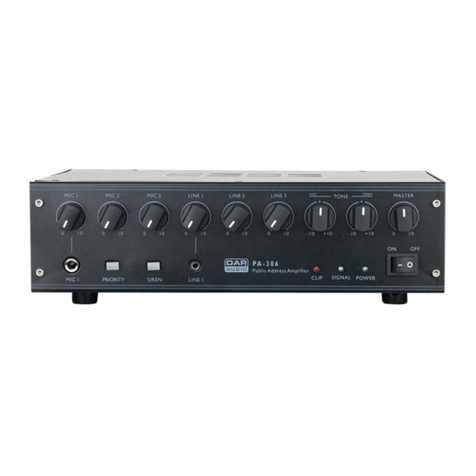
DAPAudio
DAPAudio PA-306 manual
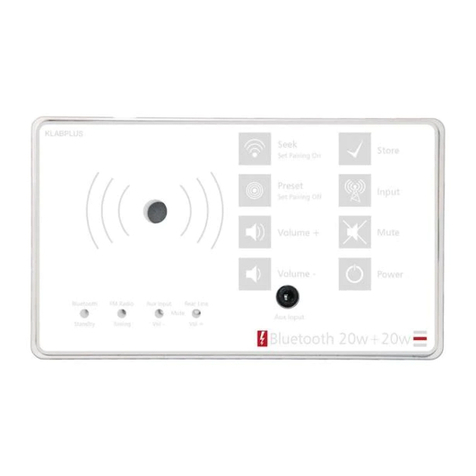
K2 Audio
K2 Audio KLABPLUS Setup and installation guide

WPI
WPI Biological Signals Amplifier instruction manual

Hubbell
Hubbell GAI-TRONICS SP2 instruction manual
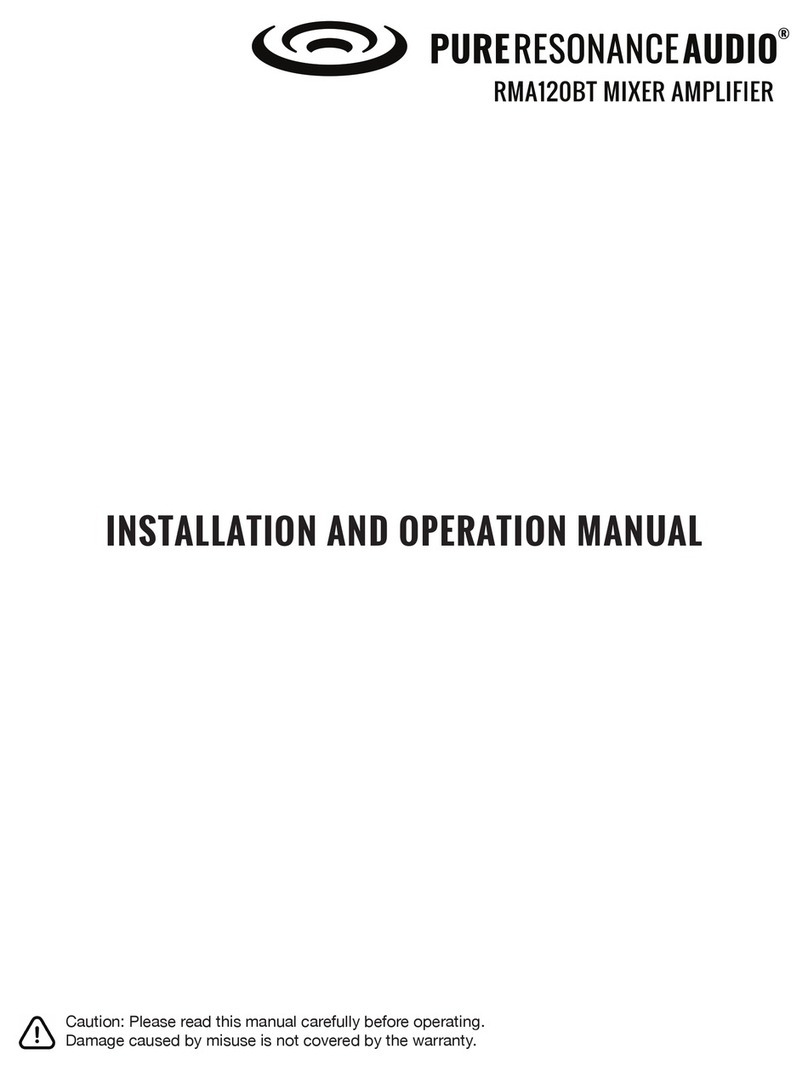
Pure Resonance Audio
Pure Resonance Audio RMA120BT Installation and operation manual
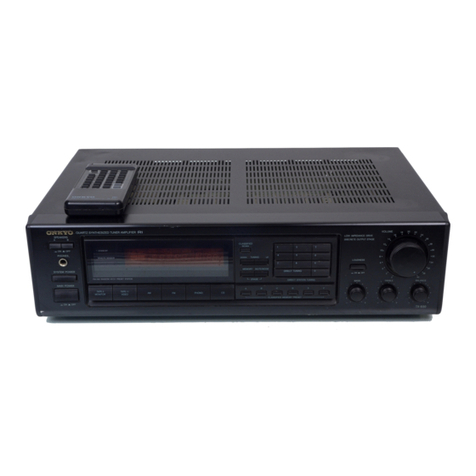
Onkyo
Onkyo TX-910 Service manual

